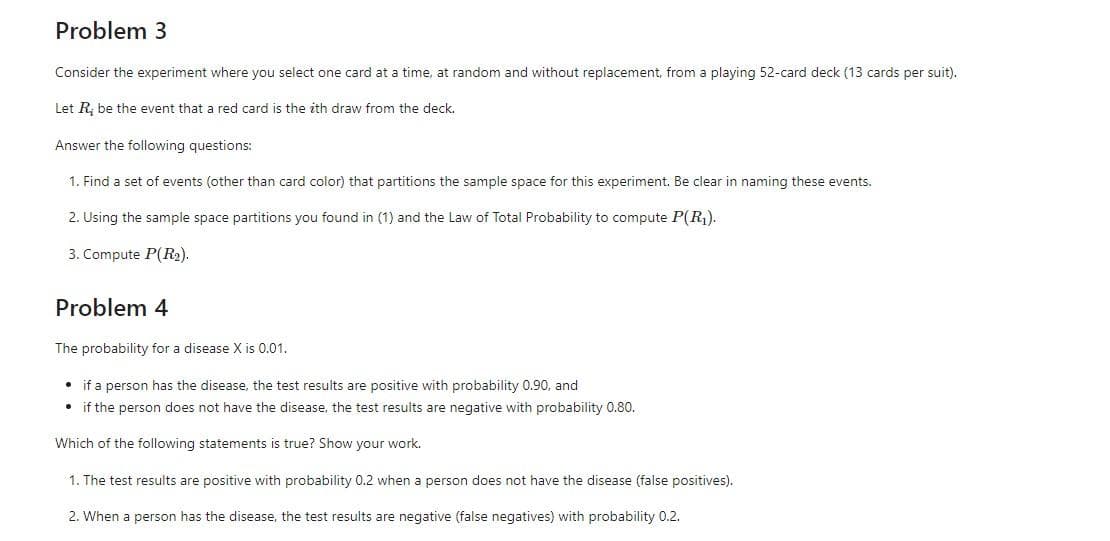Consider the experiment where you select one card at a time, at random and without replacement, from a playing 52-card deck (13 cards per suit). Let R, be the event that a red card is the ith draw from the deck. Answer the following questions: 1. Find a set of events (other than card color) that partitions the sample space for this experiment. Be clear in naming these events. 2. Using the sample space partitions you found in (1) and the Law of Total Probability to compute P(R). 3. Compute P(R2). Broblo
Consider the experiment where you select one card at a time, at random and without replacement, from a playing 52-card deck (13 cards per suit). Let R, be the event that a red card is the ith draw from the deck. Answer the following questions: 1. Find a set of events (other than card color) that partitions the sample space for this experiment. Be clear in naming these events. 2. Using the sample space partitions you found in (1) and the Law of Total Probability to compute P(R). 3. Compute P(R2). Broblo
MATLAB: An Introduction with Applications
6th Edition
ISBN:9781119256830
Author:Amos Gilat
Publisher:Amos Gilat
Chapter1: Starting With Matlab
Section: Chapter Questions
Problem 1P
Related questions
Question

Transcribed Image Text:Problem 3
Consider the experiment where you select one card at a time, at random and without replacement, from a playing 52-card deck (13 cards per suit).
Let R; be the event that a red card is the ith draw from the deck.
Answer the following questions:
1. Find a set of events (other than card color) that partitions the sample space for this experiment. Be clear in naming these events.
2. Using the sample space partitions you found in (1) and the Law of Total Probability to compute P(R1).
3. Compute P(R2).
Problem 4
The probability for a disease X is 0.01.
• if a person has the disease, the test results are positive with probability 0.90, and
• if the person does not have the disease, the test results are negative with probability 0.80.
Which of the following statements is true? Show your work.
1. The test results are positive with probability 0.2 when a person does not have the disease (false positives).
2. When a person has the disease, the test results are negative (false negatives) with probability 0.2.
Expert Solution
This question has been solved!
Explore an expertly crafted, step-by-step solution for a thorough understanding of key concepts.
This is a popular solution!
Trending now
This is a popular solution!
Step by step
Solved in 3 steps

Recommended textbooks for you

MATLAB: An Introduction with Applications
Statistics
ISBN:
9781119256830
Author:
Amos Gilat
Publisher:
John Wiley & Sons Inc

Probability and Statistics for Engineering and th…
Statistics
ISBN:
9781305251809
Author:
Jay L. Devore
Publisher:
Cengage Learning

Statistics for The Behavioral Sciences (MindTap C…
Statistics
ISBN:
9781305504912
Author:
Frederick J Gravetter, Larry B. Wallnau
Publisher:
Cengage Learning

MATLAB: An Introduction with Applications
Statistics
ISBN:
9781119256830
Author:
Amos Gilat
Publisher:
John Wiley & Sons Inc

Probability and Statistics for Engineering and th…
Statistics
ISBN:
9781305251809
Author:
Jay L. Devore
Publisher:
Cengage Learning

Statistics for The Behavioral Sciences (MindTap C…
Statistics
ISBN:
9781305504912
Author:
Frederick J Gravetter, Larry B. Wallnau
Publisher:
Cengage Learning

Elementary Statistics: Picturing the World (7th E…
Statistics
ISBN:
9780134683416
Author:
Ron Larson, Betsy Farber
Publisher:
PEARSON

The Basic Practice of Statistics
Statistics
ISBN:
9781319042578
Author:
David S. Moore, William I. Notz, Michael A. Fligner
Publisher:
W. H. Freeman

Introduction to the Practice of Statistics
Statistics
ISBN:
9781319013387
Author:
David S. Moore, George P. McCabe, Bruce A. Craig
Publisher:
W. H. Freeman